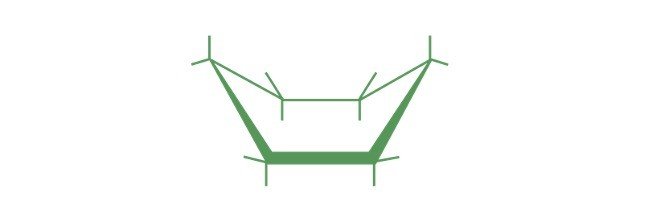Carbohyderate and Disaccharide
Carbohydrates are one of the organic molecules that are made up of carbon hydrogen and oxygen in the ratio of 1:2:1. These are considered as the major classes of the biomolecules which serves as an important source of an energy. These compounds also play a role in serving as the structural components. Carbohydrates are generally classified into two major groups as simpler carbohydrates and the complex carbohydrates.
Simpler carbohydrates are also known as simple sugar which can be easily digested and it can also be served as the rapid source of energy. Whereas the Complex carbohydrates like cellulose, starch and glycogen takes more time to get digested and metabolized as they are high in fiber unlike simple carbohydrates as they are less likely to cause spikes in the blood sugar.
What are Disaccharide?
The term disaccharide generally refers to the two molecules of monosaccharides. A saccharide generally refers to the structural unit of the carbohydrates. Hence, disaccharide is a compound of carbohydrate which is made up two units of monosaccharides. The term sugar can be referred to as both Monosaccharides and disaccharides.
Monosaccharides are also known as simple sugars as they form the most fundamental type of sugar which is generally known as sucrose. Where as the term table sugar refers to the granulated form of sugar which is referred to as the sucrose. Disaccharide is made up of two monosaccharides namely glucose and fructose.
Characteristic of Disaccharide
Like carbohydrates, disaccharides are also made up of molecules like carbon, hydrogen and oxygen in the ratio of 2:1 which are then referred to as the hydrates of the carbon. Disaccharide are the organic compounds which are linked together by a covalent bond. Disaccharides are the sugar base that comprises of two molecules of monosaccharides that are linked together by a glycosidic bond. Monosaccharides are considered as the most fundamental compound of the carbohydrate.
Glycosidic bonds are considered as the covalent bonds which are formed by two hydroxyl groups having two monosaccharides. Though disaccharides are made up of same chemical formula they are classified into three different kinds however they differ in bond formation and they constitute different properties.
However, disaccharides vary from the other forms of carbohydrates, oligosaccharides and the polysaccharides which all make up the unit of the sugar. Thus, disaccharides are made up of two monosaccharides and the oligosaccharides are made up of three to ten molecules of monosaccharides. Whereas the polysaccharide is made up of several units of monosaccharides.
Disaccharide Synthesis
The chemical process in which the monosaccharides are joined together are known as dehydration synthesis as it results in release of the byproduct, water. Disaccharides are generally formed by displacing a molecule of hydroxyl from the one monosaccharide and the proton taken form the other molecules of monosaccharide.
Thus, formation of two monosaccharides linked together by a covalent bond. Further the proton and the hydroxyl groups are detached and joined to form a water molecule. Thus, disaccharides are formed by the condensation process of two monosaccharide molecules.
Disaccharide is reverted into the monomeric components of monosaccharides by the process of hydrolysis along with the helps of an enzyme disaccharidase. Whereas the condensation process involves the elimination of the water, where it is utilized by the process of hydrolysis.
Classification of Disaccharide and Disaccharide Examples
Disaccharides are generally classified into two types namely reducing and the non-reducing.
A reducing disaccharide is one of the types of disaccharide in which the reducing sugar contains a free hemiacetal unit which serves as the reducing aldehyde group. Examples of one such reducing disaccharide is maltose or cellobiose.
On the other hand, the Non-reducing disaccharides are the ones which do not act as a reducing agent. Both monosaccharides which makes up the molecule of disaccharide does not have hemiacetal unit as they bond through the linkage of the acetal between the anomeric centers. Examples of such non-reducing disaccharides are sucrose and the trehalose.
Importance of Disaccharide
Dietary disaccharides are the other form of carbohydrates which serves as a source of energy. As we intake and digest the disaccharides they are break down into units of monosaccharides which play an important role in metabolizing them for synthesizing the ATP molecules and thus generating the energy. ATPs are thus considered as the biologically synthesized molecules through the process of aerobic and anaerobic respiration.
Glucose is considered as one of the most common form of monosaccharide, where the cellulitis’s the synthesized ATP through the substrate level of phosphorylation. Whereas one of the sources of glucose is disaccharide which contains diet.
However, too much of glucose is considered as hazardous as too much of glucose and leads to diabetes and the obesity risks, and other issues like cardiovascular diseases and formation of tooth decay.
Lactose is one of the disaccharides which is found in the breast milk and it is considered as one of the most important nutrient sources for the infants. Where as the micro-organisms like Lactobacilli has its ability to convert lactose into lactic acid, which is used in the food industry for the production of diary products like yogurt and cheese. The other form of disaccharide named maltose is generally used as a sweetener even it is less in its sugar source.
Disaccharide Citations
- Disaccharide structure code for the easy representation of constituent oligosaccharides from glycosaminoglycans. Nat Methods . 2008 Apr;5(4):291-2.
- The clinical significance of disaccharide maldigestion. Am J Clin Nutr . 1994 Mar;59(3 Suppl):735S-741S.
- Disaccharide digestion: clinical and molecular aspects. Clin Gastroenterol Hepatol . 2006 Mar;4(3):276-87.
Share












